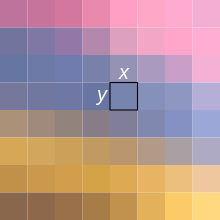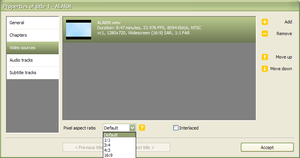Advanced Aspect Ratios - PAR
- PAR, DAR and SAR
Now first of all, I know what you're : "but you about just a few pages ago!" But are just so that I had to give them their own . this page used to later in the guide, but I it would make more sense to move it up here so you wont have to worry about it so much later.
are one of the more about video. They make as much sense as they . Close into will just get you more than you were to start off with, so I'm going to try and keep it it in a sort of way.... I've no idea if this is but here goes.
There are three main ways of ratio - P ixel A spect R atio (PAR), D A spect R atio (DAR), and S ample A spect R atio (SAR).
Pixel Ratio
A pixel is a pixel, it is a small block of color . , some have than . have and hence that is for on a have a PAR of 1. TVs have ' ' which have a PAR on the (NTSC or PAL).
Full NTSC dvd is and PAL dvd is . This is be shown on a 4:3 TV... but these aren't 4:3 , so what's going on?
The for this (I'm here) is due to the fact that TVs have and when you show the above on a TV they will look 4:3.
In terms it means that when you look at dvd (, ) on a PC they do not have the p ixel a spect r atio so they look a tiny bit / in to the way they look on a TV. This is . that are for DVD video on your PC will this when they are the by it so it looks right, but if you are it with a " " then it will look wrong. The good thing is that it doesn't until you your final as to what PAR has. You have a video of a to edit with and no what PAR you it in you still have that many .
NTSC has a PAR of 0.911 and PAL has a PAR of 1.094 but we are going to work from the - on a PC , NTSC dvds need to to be 4:3 and PAL DVDs need to . This is a of the truth but it suits us well .
[You may that NTSC is and PAL is - this is and to keep the the same in case uses these on an ]
Now at this point, I have yet to on you. You know how I said NTSC DVD is ? Well, that's not true. 8 on each the left and right side of the image are to be just empty space, and aren't even to even be ! Got that?
Here is a math just to make sure you see what is here:
A DVD is , but 8 off each side, we get .
704*0.911/480 = 641.344/480 = close to 640/480
640/480 = 4/3 = 1.333...
Ratio
In mpeg video this is often as a flag that says "this is the ratio that you me at". There are two D A spect R atios (DARs) on a DVD - 4:3 and 16:9. TV shows will be 4:3 and will be 16:9 they are pan&scan or (see below). with a 16:9 DAR are what we refer to as (or as " for TV" etc).
So, what is ?
Let me with an NTSC dvd : Girl Utena the Movie (aka of Utena)
The of an NTSC dvd is and is for 4:3 . , in order to the of being used, a movie is to fit that like this ( are 1/2 size):
This means that the video is using all of the of the DVD and it also means that TVs only have to the image - which is also good for .
o for the image is :9so the image, when shown , will look like this:
That image was made by the image , just like a TV would do. If you were it on a4:3 , you might be able to set it so the 16:9 image like this:
will be . Those have a 4:3 DAR and the has black on the top and just like the image above. This is a waste of good . , it is a when for (and anime ) that or for 16:9 DAR.
way of with a and a 4:3 DAR is to do and will a 4:3 image from the by the edges like this:
You can see the that has been from the image by it with the image above. The of lost is even worse when you have big that have an ratio of 2.35:1 ( to 16:9 which is only 1.778:1). On DVDs with an ratio like 2.35:1 are with a 16:9 DAR but still need some they are not 16:9. The is the same as 16:9 in a 4:3 DAR and it all comes out right in the end.
Now, as if Pixel and weren't , now we have one to throw into the mix. were with the MPEG4 . As such, they have to do with DVDs! Since you might want to your AMV as an MPEG4 , it is worth what they are. are very to - they are just a hard to . , you wont ever need to an SAR by hand!
The SAR just says " the video by this ratio". So lets say for , we have a video (we took a dvd, and off those bits on the sides). If we want this video to be at an ratio of 4:3, then it would need an SAR of 10:11.
Why 10:11? Just look:
(704*10)/(480*11) = 4/3
See, it *is* easy to , right? If we that same video to be at an ratio of 16:9, then we would use an SAR of 40:33, as (704*40)/(480*33) = 16/9.
But like I said, you wont need to be these , so all you need to worry about is just how the SAR from the PAR and DAR.
Pixel ratio
From , the free
Not to be with ratio.
This alist of , links,but its it . by more .(July 2009)

Pixel ratio 1:1

Pixel ratio 2:1
Pixel ratio(often ) is a t how the width of to the of that pixel.
an image as a grid of tiny, . , some , those that must be - , an image as a grid of , in which the pixel width and are . Pixel Ratio this .
Use of pixel ratio to - and some other cases. Most other , those that and , use .
[hide]
in pixel ratio and of non- of pixel with of video
[edit]
The ratio of the width to the of an image is known as ratio, or more Ratio(DAR) – the ratio of the ;for TV, DAR was 4:3 (a.k.a. ), with 16:9 (a.k.a. ) now the for HDTV. , there is a with Ratio(SAR), which is the ratio . If an image is with , then these agree; if not, then non-, "" are used, and these . The ratio of the is known as Ratio(PAR) – for this is 1:1 – and these are by the :
SAR×PAR=DAR.
( for PAR) :
PAR=DAR/SAR.
For , a 640× has a SAR of 640/480 = 4:3, and if on a 4:3 (DAR = 4:3) has , hence a PAR of 1:1. By , a 720×576D-1PAL image has a SAR of 720/576 = 5:4, but is on a 4:3 (DAR = 4:3).
In such as film there is no of pixel, nor of SAR or PAR, but in the image has , hence SAR (and PAR, if at the same ratio as the ).
Non- arise often in early TV , to of TV – whose and "" and are thus best by non- – and also in some and modes, such (CGA). Today they arise also with SARs.
do not have non- , might; they are a used in to .
There are in PAR, as it to of video:
[edit]
See also: ratio (image) §
as a of video . , video were and in form. As , , and , it in video frame that must be using Pixel Ratio. video are as a grid of used to each image. The is by (or ), and is known as a video line. The is by the of lines, as in 480 lines.
- and were as and for , and were not for video . Such an image as an array of well- "Lines", well- "Line " and a well- . , there is not a - that image edges or a of per line. , video such , of , half- in an to and the image rate for .
-to- [edit]
As a of to serve as video tools, -to- -to- made to this . To video lines into a of , the a rate at were into . The luma rate ⁄ for 576i ⁄4MHz.
The first -R BT.601( known as "Rec. 601") that - are made of lines of 720 non- . ITU-R BT.601 did not the exact pixel ratio but did to the exact pixel ratio based on : The luma rate of ⁄2MHz. Based on this :
SMPTE RP 187 to the pixel ratio . It 177:160 1035:1132 . , due to with in by and the load that they upon the , SMPTE RP 187 was . SMPTE RP 187 annex A.4 the use of 10:11 .
As of this , ITU-R BT.601-6, which is the of ITU-R BT.601, still that the pixel above are .
video [edit]
As above, ITU-R BT.601 that - are made of lines of 720 non- , with a rate. A that a 704 pixel width would be to 4:3 :
, not all TV are 4:3: As , in video, the of a is well- but the edges of the are not . As a , some ( PAL but also some NTSC ) that were () wider. This also (16:9) . , to a safe of error, ITU-R BT.601 16 more non- per line (8 more at each edge) to all video data near the .
This , , had for PAL . PAL Pixel for (4:3) and wide (16:9), 59:54 and 118:81, were for image , for PAL and NTSC video clips. , video chose the , 12:11 and 16:11, which were more and could PAL at 704 wide, as :
in pixel ratio [edit]
found on the and in other media are that and as the pixel of video and video . (See .)
To judge the and/or of these , note that as the was years after the , all video for and media, or , have (and must have) with . , the pixel ratio of video must be from the of than the of video. , any pixel ratio that is from a video is only in cases for the same kind of video and be /used as a pixel ratio of any .
In , video that has well- edges, video have never a well- edge for the . , the pixel ratio of be based on edges of . Such a ratio value would not be wrong, but also be as the pixel ratio of any video . The use of such would be only to cases.
and [edit]
In - , those that with SMPTE and , only are used for and . , some (ex.,HDV, HD) use non- for image , as a way to the of data that must be , thus the rates and with .
of non- [edit]
an image with a pixel ratio on a whose pixel ratio is makes the image look or in the or . For , a for a with looks like a on a - NTSC that uses . This issue is more on wide- TVs.
Pixel Ratio must be taken into by video that edit video files with non- , when video clips with pixel . This would be the case when a video from video (a rare ). must also take the pixel ratio into , since some of the from a point so that they look . An of such would be blur, blur, or even a image .
Use of pixel ratio[edit]
Pixel ratio value is used in video , where must be or to use video other than the . may use pixel ratio to video on . Video uses Pixel Ratio to a video into a new .
with Ratio[edit]
Main : ratio (image)

DVD Flick 1.3.0.7: a of that has pixel ratio
Pixel Ratio is often with types of image ; the ratio of the image width and . Due to non- of in - TV, there are two types of such : Ratio(SAR) Ratio(, also known Ratio). Note that io can be . This the Pixel Ratio and , uses the term " Ratio" and the "DAR" where .
Ratio is the ratio of the image width to in , and can be from the video file. Ratio is the ratio of image width to (in a unit of such as or ) when on , and is from the of Pixel Ratio and Ratio.
, users who know the of these may get as well. user- or can cause such : Some video- often ask users to an " Ratio" for their video file, him or her with the of "4:3" and "16:9". , these may be "PAL 4:3", "NTSC 4:3", "PAL 16:9" and "NTSC 16:9". In such , the video is for the Pixel Ratio of the video file by for about the video from which the video file . The then uses a table ( to the one below) to the pixel ratio value.
, to avoid , it can be that video never ask for the Ratio as they can or it. -pixel–aware also need only to ask for Pixel Ratio or Ratio, from of which they can the other.
Pixel of video [edit]
Pixel ratio for - video are below. Note that for PAL video , two types of pixel ratio are :
Rec.601, a Rec.601- value, which is the real Pixel Ratio of - video of that type., which is to Rec.601 and is more to use in Video .
Note that on PARs for – for , 576 lines (PAL) at 4:3 (DAR) to PAR of 12:11 (if 704×576, SAR = 11:9), or a PAR of 16:15 (if 720×576, SAR = 5:4). both, : a table of , and pixel .
Video DAR
(px × px) PAR PAR () Width (px)
Rec.601 Rec.601 Rec.601
PAL
4:3
704×576
59:54
12:11
1.0925
1.09
769, 385
768, 384
16:9
118:81
16:11
1.
1.45
1026, 513
1024, 512
NTSC
4:3
704×480
10:11
0.90
640, 320
16:9
40:33
1.21
853, 427
HDV/HDCAM
16:9
1440×1080
4:3
1.3
1920












